30 November, 1999
I caught a big fish! How big was it? It was so big that when we went
ice fishing, we had to pull the ice auger with a bulldozer. It was so big;
we had to use 1000-pound test steel cable for line. It was so big; we used a
power winch to haul it in. It was so big; it took 4 people to carry the live
box. Does this sound like a fish story? It is and it is all true. This
fisherman never lies.
I had the opportunity to join a group of fish researchers to collect
a species of fish known as Dissostichus mawsoni. This fish is also known as
the Antarctic Toothfish or, more commonly, the Antarctic Cod. These fish are
very fascinating animals. They live in waters that have temperatures below
the freezing point of fresh water (-2C and lower). The blood of most fishes
would freeze at this temperature. Some cold blooded organisms that live in
the cold oceans have body fluids that have the same salt concentration as
sea water, so they have the same freezing point as the surrounding water and
therefore won't freeze even when the temperature of the sea water is below
0C. Warm-blooded animals, like seals and penguins, keep from freezing by
producing heat and insulating themselves with blubber, fur, feathers, etc.
Fish, however, are cold blooded (their body temperature is the same as their
environment.), but they have a salt content in their blood much lower then
sea water. Most fish would freeze if they were put in the water below the
ice in the Ross Sea. The d. mawsoni, along with several other species of
fish, have evolved a number of unique antifreeze compounds called antifreeze
glycoproteins (AFGP). The AFGP prevent the d. mawsoni from freezing in the
cold Antarctic waters. As I discussed yesterday, researchers in the McMurdo
area do a lot of research on the AFGPs in the fish.
The Antarctic Cod is a relatively deep-water fish living in depths
of 90 to 1600 meters (300-5000ft). We fished for them in about 470 meters
(1500 feet) of water. Mawsoni eat other fish and are preyed upon by seals
and probably other large fish. I went out with fish researchers Andor Kiss,
Nelyn Soto, Terri McClain and Kevin Hoeflag to collect some cod for use in
their AFGP research. Lines with bait had been set out the night before. The
cable was lowered into the sea using a power winch. At 10-meter intervals
from the bottom 9 large hooks are clamped onto the cable. Bait fish
(Pagothenia borchgrevinki) about 8 inches long are placed on each hook. The
next morning, we went to haul the fish in. The cable was pulled in using the
winch and the catch, if any, was hauled in. It takes quite a while to pull
up the line from 1500 feet. After about 15 minutes or so a large shape
started to appear in the hole. We had one! It was a 67 pound, 55 inch
Antarctic Cod. What an impressive sight! Kevin carefully lifted the fish out
of the hole and removed the hook. The fish was weighed and measured and
placed in the "fish coffin", an aerated live box built to hold two or three
of these big fish. We continued to raise the line. The next fish was 80
pounds and 61 inches long. It was the largest we caught today. I got to hold
this one and measure it. The next hook was empty but the one after that had
a cod on it and I got to land and handle this one myself. It was quite a
thrill! Of the 9 hooks set, we got 6 live fish between 80 and 32 pounds. The
last hook had a cod on it, but it had died on the hook. It was covered with
small shrimp-like scavengers called amphipods. They can consume the entire
carcass in a short period of time.
After we pulled all the lines up, a trap for baitfish was attached to the
line and lowered into the water. Terri had also designed a special trap to
capture an Antarctic species of fish that has never been studied before. So
far the fish has avoided capture, but Terri is going to keep trying. We
loaded the 6 cod into the aerated carrying boxes and it took 4 of us to
carry them to the Sprite for the trip back to the aquarium. Once back at
McMurdo, we placed some of the fish into tanks for further study. Blood and
tissue was extracted from others in order to isolate and identify the AFGP's
in the fish. Andor collected blood, liver and gill samples while Nelyn took
the rest of the guts for sampling. Lot's of information will be gathered
from these samples.
There are lots of Antarctic Cod in McMurdo Sound and surrounding waters. The
fish can only be killed for scientific studies. However, each year poaching
of these large, good tasting fish becomes more and more of a problem. The
Patagonian Toothfish, a close relative of d. mawsoni that lives closer to
the southern tip of South American, is being fished to extinction.
Enforcement of the Antarctic Treaty that prohibits commercial fishing of
Antarctic species is hard to enforce in such a large ocean. Some countries
have not signed the treaty and may continue to try to exploit the animals of
this fragile region.
I was very fortunate to be part of the group studying these magnificent
fish. I want to thank Andor, Nelyn, Kevin and Terri for letting me part of
the team for a little while. I wish them luck with their future research.
I am scheduled to leave Antarctica on Saturday, December 4th,
weather permitting. The C-141 that I flew me here can no longer land on the
sea ice runway because it only has wheels and is too heavy for the
deteriorating sea ice. I will be flying home in a C-130 Hercules aircraft
operated by the 109th Airlift Command of the Air National Guard. Tomorrow we
will look closer at these cool aircraft and the crews that fly them.

Here is the first Mawsoni coming out of the icy depths of the Ross Sea. It weighed 67 pounds!
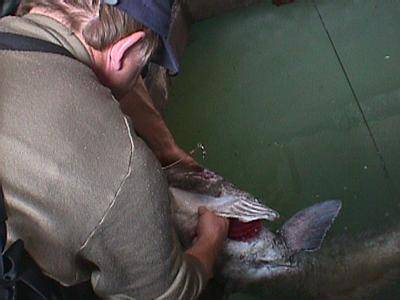
Here I am lifting one of the big fish out of the hole. You've got to be careful of the teeth, the hooks and the cold water.
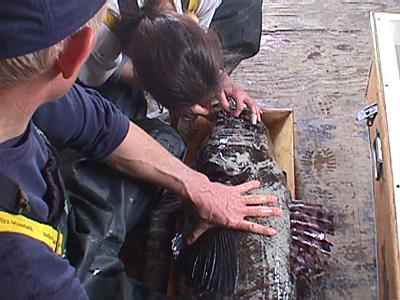
Kevin and Terry take measurements of this big Mawsoni. Careful records are kept of each fish they catch.
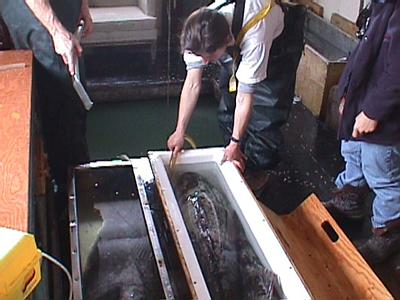
Terri fills the "fish coffin" with sea water. The box is covered and aerated for the trip back to the aquarium.
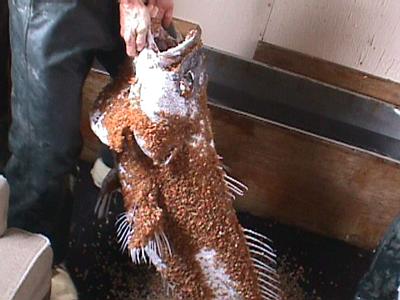
Oh, Gross! Here is the dead cod covered with amphipods. We put this one back into the sea. The amphipods will quickly dispose of the fish.
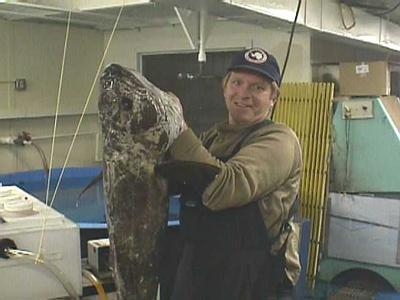
Putting a big Mawsoni into the aquarium tanks at McMurdo.
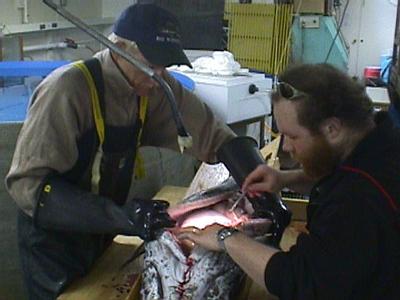
Kevin, on left, and Andor remove blood and tissue samples used to study the antifreeze proteins that keep these fish from freezing in the cold Antarctic waters.

An 80 pound Antarctic Cod. Now I have a real fish story to share with my fishing buddies back on the ice in Wisconsin.
Contact the TEA in the field at
.
If you cannot connect through your browser, copy the
TEA's e-mail address in the "To:" line of
your favorite e-mail package.
|
